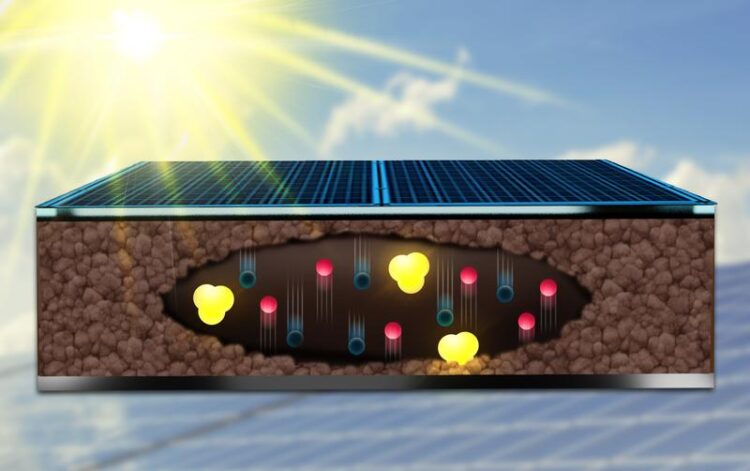How charges move in solar cells

A complex dance: In a perovskite solar cell, electrons, holes and ions move and influence each other.
© MPI-P
When the sun rises, a complex dance begins in perovskite solar cells – a type of solar cell that can supplement or replace existing silicon solar cells in the future: Electrons are supplied with energy by light and move. Where electrons move, they leave holes. At the same time, ions move around in the perovskite material. An understanding of this complex dance – i.e. how exactly these particles move – can help to increase the efficiency of solar cells. Gert-Jan Wetzelaer, group leader at the Max Planck Institute for Polymer Research (MPI-P) in Mainz, and his team have used a combination of experiments and computer simulations to get closer to the microscopic processes.
When light falls on a solar cell, its energy is transferred to electrons, which in turn can supply a device with electricity – this is the simple explanation of solar cells. But microscopically speaking, many different processes take place: When the electron is moved, it leaves a hole – which acts like a positive charge and moves in the opposite direction through the solar cell material – a semiconductor. At the same time, novel solar cells based on new perovskite materials additionally contain charged atoms, so-called ions, which also move around in the solar cell and interact with electrons and holes.
In this complex interplay, it is desirable to transport electrons or holes to the contacts of the solar cell as quickly as possible – because the longer they remain in the material, the greater the probability that they will lose their energy by other means and return it to the material. To optimize this time, it is important to have precise knowledge of the so-called “mobility” – i.e. the speed – of electrons and holes. However, this was difficult to access in a working solar cell because of this complex interplay between electrons, holes and slow-moving ions.
Gert-Jan Wetzelaer and his research colleagues have first measured the speed and the amount of the additional ions present in the perovskite material. With this information they were able to perform computer simulations, which could be used to obtain the electron and hole mobility from electrical current measurements. They have thus discovered that the holes in particular move more slowly than originally thought.
“These results are very important in order to be able to optimize the efficiency of solar cells in the future,” says Wetzelaer. “After all, if we understand more precisely the exact processes that limit the mobility of electrons and holes, we can look for ways to circumvent them”.
The scientists have now published their results in the renowned journal “Nature Communications”.
Wissenschaftliche Ansprechpartner:
Dr. Gert-Jan Wetzelaer
Tel.: 06131 – 379 558
Email: wetzelaer@mpip-mainz.mpg.de
Originalpublikation:
Sajedi Alvar, M., Blom, P.W.M. & Wetzelaer, G.A.H. Space-charge-limited electron and hole currents in hybrid organic-inorganic perovskites. Nat Commun 11, 4023 (2020). https://doi.org/10.1038/s41467-020-17868-0
Weitere Informationen:
https://www.mpip-mainz.mpg.de/en/blom/gruppen/wetzelaer – Website of Gert-Jan Wetzelaer
https://www.mpip-mainz.mpg.de/en/blom – Website of the department of Paul Blom
Media Contact
All latest news from the category: Power and Electrical Engineering
This topic covers issues related to energy generation, conversion, transportation and consumption and how the industry is addressing the challenge of energy efficiency in general.
innovations-report provides in-depth and informative reports and articles on subjects ranging from wind energy, fuel cell technology, solar energy, geothermal energy, petroleum, gas, nuclear engineering, alternative energy and energy efficiency to fusion, hydrogen and superconductor technologies.
Newest articles

Parallel Paths: Understanding Malaria Resistance in Chimpanzees and Humans
The closest relatives of humans adapt genetically to habitats and infections Survival of the Fittest: Genetic Adaptations Uncovered in Chimpanzees Görlitz, 10.01.2025. Chimpanzees have genetic adaptations that help them survive…

You are What You Eat—Stanford Study Links Fiber to Anti-Cancer Gene Modulation
The Fiber Gap: A Growing Concern in American Diets Fiber is well known to be an important part of a healthy diet, yet less than 10% of Americans eat the minimum recommended…

Trust Your Gut—RNA-Protein Discovery for Better Immunity
HIRI researchers uncover control mechanisms of polysaccharide utilization in Bacteroides thetaiotaomicron. Researchers at the Helmholtz Institute for RNA-based Infection Research (HIRI) and the Julius-Maximilians-Universität (JMU) in Würzburg have identified a…



